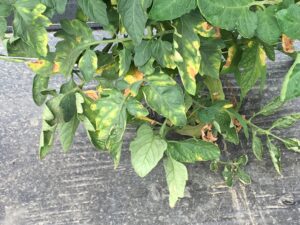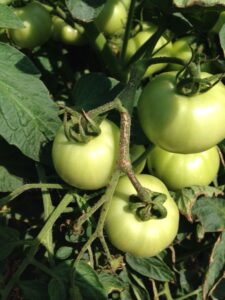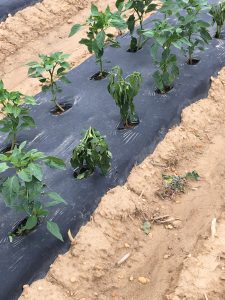Sweet Corn
Low numbers of European corn borer (ECB) moths continue to be captured at levels similar to last week, and feeding in whorl and pre-tassel stage corn more common. The highest adult activity remains in Hunterdon County (see map below at right). ECB injury over the threshold of 12% of plants infested has been found in many areas this week. It is typical for feeding percentages to rise as the moth catch declines. We expect feeding to increase for the next week or so before peaking.
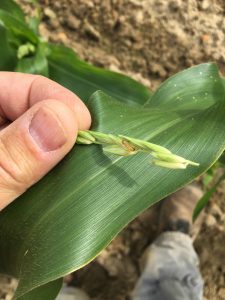 Look for the characteristic “shot-hole” type of feeding (photo below at right) and consider treating when infested plants exceed 12% in a 50 plant sample. As plantings proceed to the pre-tassel stage, ECB larvae may be found in emerging tassels (see photo at left). It is a good idea to treat individual plantings as they move into the full tassel/first silk stage one time. This eliminates any ECB larvae that have emerged with the tassels as they begin to move down the stalk to re-enter near developing ears.
Look for the characteristic “shot-hole” type of feeding (photo below at right) and consider treating when infested plants exceed 12% in a 50 plant sample. As plantings proceed to the pre-tassel stage, ECB larvae may be found in emerging tassels (see photo at left). It is a good idea to treat individual plantings as they move into the full tassel/first silk stage one time. This eliminates any ECB larvae that have emerged with the tassels as they begin to move down the stalk to re-enter near developing ears.
Useful insecticides for this particular application include synthetic 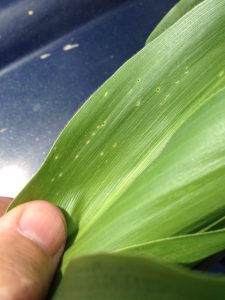 pyrethroids (IRAC Grp 3), spinosyns (including OMRI approved Entrust) IRAC Grp 5), and diamides such as Coragen or Vantacor (IRAC Grp 28) or materials such as Besiege which include the active ingredient in Coragen. Synthetic pyrethroids alone should NOT be used for corn earworm (CEW) protection on silking corn. Control with these materials is very inconsistent.
pyrethroids (IRAC Grp 3), spinosyns (including OMRI approved Entrust) IRAC Grp 5), and diamides such as Coragen or Vantacor (IRAC Grp 28) or materials such as Besiege which include the active ingredient in Coragen. Synthetic pyrethroids alone should NOT be used for corn earworm (CEW) protection on silking corn. Control with these materials is very inconsistent.
The highest nightly trap catches of ECB for the week ending 6/22/22 are as follows:
| Sergeantsville 2 | Califon 1 | Old Bridge 1 |
| Allentown 1 | Clinton 1 | Pedricktown 1 |
| Asbury 1 | Dayton 1 | Princeton 1 |
| Bellemeade 1 | Hillsborough 1 | South Branch 1 |
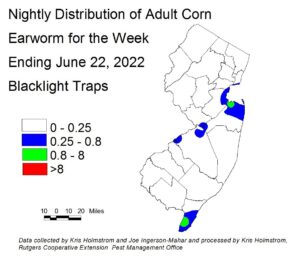 Corn earworm (CEW) moths captures from blacklight traps have decreased around the state. We will use a combination of pheromone and blacklight trap types to derive silk spray schedules by region. At present, pheromone trap captures are similar to last weeks numbers, and are indicating more conservative silk spray schedules throughout the state. The number of pheromone traps deployed is much lower, resulting in much broader color bands on the map. It is also important to understand that pheromone traps are more sensitive than blacklight traps, and thresholds are adjusted to account for the higher catches typical of this trap type. Silking corn is at risk of CEW infestation at this time. On the blacklight map (left), green areas represent a 3-4 day silk spray schedule and blue represents a 4-5 day schedule. On the pheromone map, red represents a 3-day schedule and green represents a 4-5 day schedule. Blue and white areas on the pheromone map correspond to a 5-6 day spray schedule. Be sure to access information from this publication in the upcoming weeks to determine how frequently you should treat silking sweet corn to protect it from CEW infestation.
Corn earworm (CEW) moths captures from blacklight traps have decreased around the state. We will use a combination of pheromone and blacklight trap types to derive silk spray schedules by region. At present, pheromone trap captures are similar to last weeks numbers, and are indicating more conservative silk spray schedules throughout the state. The number of pheromone traps deployed is much lower, resulting in much broader color bands on the map. It is also important to understand that pheromone traps are more sensitive than blacklight traps, and thresholds are adjusted to account for the higher catches typical of this trap type. Silking corn is at risk of CEW infestation at this time. On the blacklight map (left), green areas represent a 3-4 day silk spray schedule and blue represents a 4-5 day schedule. On the pheromone map, red represents a 3-day schedule and green represents a 4-5 day schedule. Blue and white areas on the pheromone map correspond to a 5-6 day spray schedule. Be sure to access information from this publication in the upcoming weeks to determine how frequently you should treat silking sweet corn to protect it from CEW infestation.
The highest nightly blacklight trap catches of CEW for the week ending 6/22/22 are as follows:
| Matawan 2 | Sergeantsville 1 |
| Cinnaminson 1 | Tabernacle 1 |
| Green Creek 1 | |
| Port Murray 1 |
The highest nightly pheromone trap catches of CEW for the week ending 6/22/22 are as follows: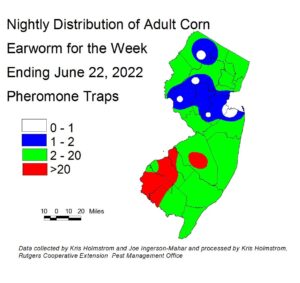
| Monroeville 83 | Beckett 10 | Berlin 4 |
| Woodstown 40 | Elm 6 | East Vineland 4 |
| Tabernacle 26 | Allamuchy 5 | Georgetown 4 |
| Pedricktown 11 | Folsom 5 | Farmingdale 3 |
Silking Spray Schedules*:
South – 3-4 days
Central – 4-5 days
North – 5-6 days
*These recommendations are based on regional catches. Adhere to tighter spray schedules if indicated by local trap catches. Synthetic pyrethroids alone should NOT be used for corn earworm (CEW) protection on silking corn, or for fall armyworm (FAW) management at any stage. Control with these materials is very inconsistent.
Tomatoes
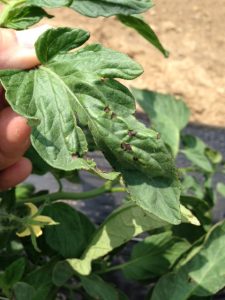 Bacterial leaf spot (BLS) symptoms have begun to appear in a few northern NJ tomato fields. Symptoms of this infection include small, very dark lesions appearing on foliage of any age (see photo at left). Often even immature, unexpanded leaves are affected. Copper resistance in BLS populations in NJ has been identified. Additionally, one incidence (so far) of bacterial canker has been detected in scouted plantings in central NJ. This disease is first characterized by marginal lesions on older foliage (photo below at left). These lesions work inward, ultimately killing entire leaves. Fruit lesions, also called bird’s eye spot (photo below at center) are initiated on very small fruit but become apparent as fruit enlarge. Dry lesions also may form on petioles (photo below at right). It is advisable that growers avoid working in fields when foliage is wet, to avoid easy spread of infections. Growers should also work from youngest blocks to oldest, to limit the chance of spreading disease to younger plants. Pruning, tying and harvesting are all ways that these diseases are dispersed throughout plantings. Bacterial infections in the field may be mitigated to some degree with systemic immune response activator Actigard, although results are often limited if weather and human activity favor spread. See the Tomato Section of the 2022/23 Commercial Vegetable Production Recommendations for further information.
Bacterial leaf spot (BLS) symptoms have begun to appear in a few northern NJ tomato fields. Symptoms of this infection include small, very dark lesions appearing on foliage of any age (see photo at left). Often even immature, unexpanded leaves are affected. Copper resistance in BLS populations in NJ has been identified. Additionally, one incidence (so far) of bacterial canker has been detected in scouted plantings in central NJ. This disease is first characterized by marginal lesions on older foliage (photo below at left). These lesions work inward, ultimately killing entire leaves. Fruit lesions, also called bird’s eye spot (photo below at center) are initiated on very small fruit but become apparent as fruit enlarge. Dry lesions also may form on petioles (photo below at right). It is advisable that growers avoid working in fields when foliage is wet, to avoid easy spread of infections. Growers should also work from youngest blocks to oldest, to limit the chance of spreading disease to younger plants. Pruning, tying and harvesting are all ways that these diseases are dispersed throughout plantings. Bacterial infections in the field may be mitigated to some degree with systemic immune response activator Actigard, although results are often limited if weather and human activity favor spread. See the Tomato Section of the 2022/23 Commercial Vegetable Production Recommendations for further information.
Peppers
Phytophthora crown rot has begun to appear in some fields following warm temperatures and high soil moisture. Look for clusters of wilting plants (photo at right). Inspect the stem near the soil line. If a black lesion is present, it 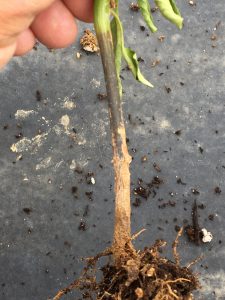 is likely that Phytophthora is responsible (photo at left). Please see Dr. Andy Wyenandt’s post of 5/30/21 regarding Phytophthora management.
is likely that Phytophthora is responsible (photo at left). Please see Dr. Andy Wyenandt’s post of 5/30/21 regarding Phytophthora management.
Pepper weevil – Pheromone traps have been set out across southern New Jersey. As yet, no weevils have been trapped and no fields are known to be infested. A fact sheet is now available for anyone interested in monitoring for pepper weevils on their own: FS1330: Monitoring and Management of Pepper Weevil in New Jersey (Rutgers NJAES).
Potato Leafhopper
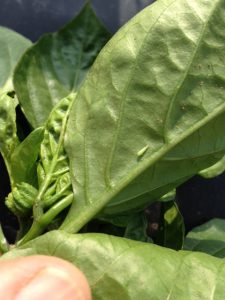 Potato leafhopper (PLH) adults (see photo at left) have appeared in snap beans and other crops over the past week. This pest is a particular problem because it often goes unnoticed until foliar distortion and burn occurs. Once this damage appears in beans and some potato varieties, yields have already been compromised. It is critical that beans be monitored regularly for the presence of PLH. If a sweep net is available, consider treating if more than 100 nymphs and adults are present in 20 sweeps of pre-bloom stage plants. This threshold increases to 250 during bloom and to 500 per 20 sweeps during pod development. If no sweep net is available, check plants in 10 random field locations and consider treating if adults and nymphs are found throughout. Adults are pale green, and will fly out from foliage when disturbed and immediately fly back into the plant canopy. Nymphs are wingless and bright green and may be found on the underside of leaves.
Potato leafhopper (PLH) adults (see photo at left) have appeared in snap beans and other crops over the past week. This pest is a particular problem because it often goes unnoticed until foliar distortion and burn occurs. Once this damage appears in beans and some potato varieties, yields have already been compromised. It is critical that beans be monitored regularly for the presence of PLH. If a sweep net is available, consider treating if more than 100 nymphs and adults are present in 20 sweeps of pre-bloom stage plants. This threshold increases to 250 during bloom and to 500 per 20 sweeps during pod development. If no sweep net is available, check plants in 10 random field locations and consider treating if adults and nymphs are found throughout. Adults are pale green, and will fly out from foliage when disturbed and immediately fly back into the plant canopy. Nymphs are wingless and bright green and may be found on the underside of leaves.
Cucurbit Downy Mildew
Cucurbit downy mildew has been detected on cucumbers in southern New Jersey (see Dr. Wyenandt’s cucurbit downy mildew alert of 6/11/22. All cucumber plantings should be protected at this time. Useful materials for CDM may be found in the Cucumber Section of the 2022/23 Commercial Vegetable Production Recommendations. A sentinel plot is now established at Snyder Farm in Hunterdon County. This plot, consisting of pumpkin, watermelon, cantaloupe, butternut, acorn, cucumber and kabocha squash will be used to indicate the presence of cucurbit downy mildew in the region, and what crops are affected. For regional information on this important disease, see the Cucurbit Downy Mildew Forecast webpage: http://cdm.ipmpipe.org/. As of Wednesday June 22, the forecast was for moderate risk of new infection in southern NJ. Again, the current local infection is impacting cucumber only.
